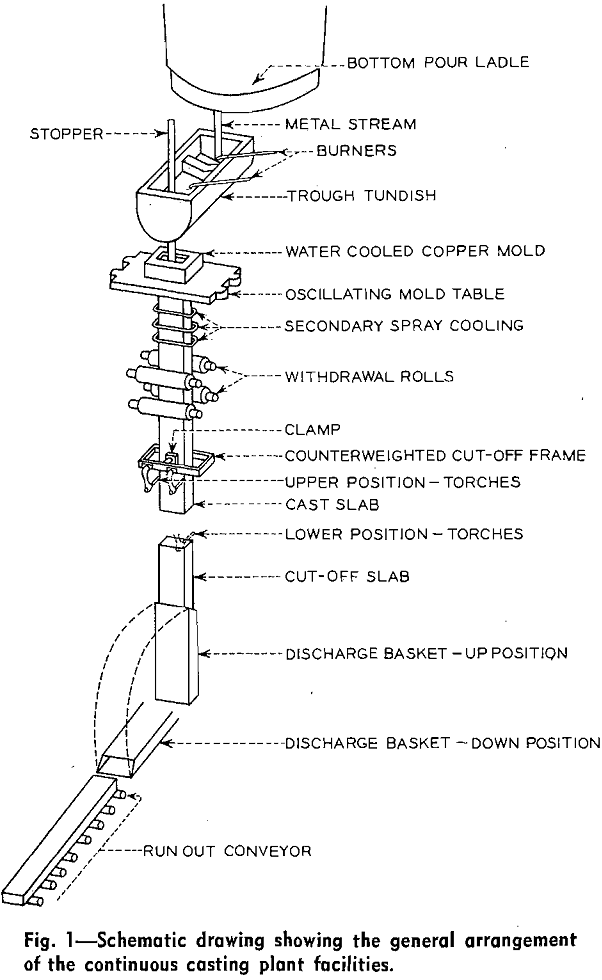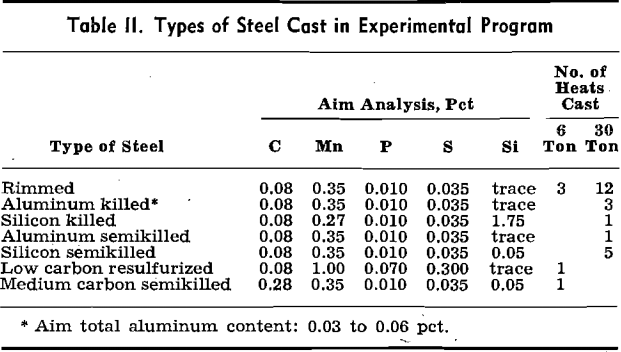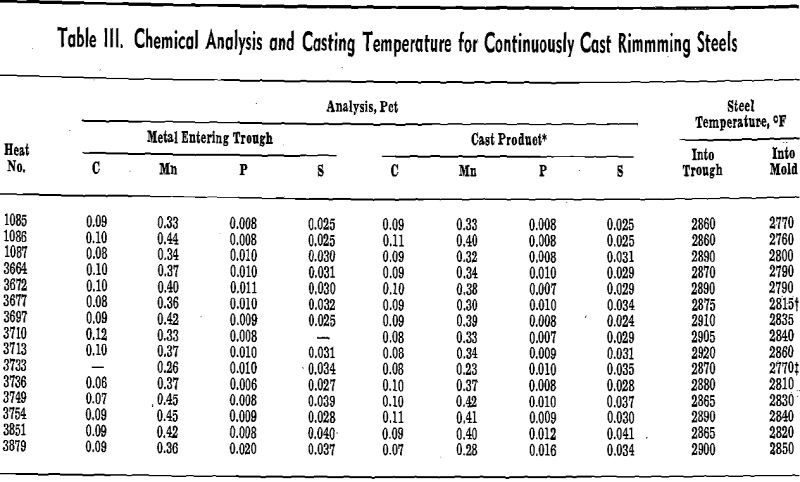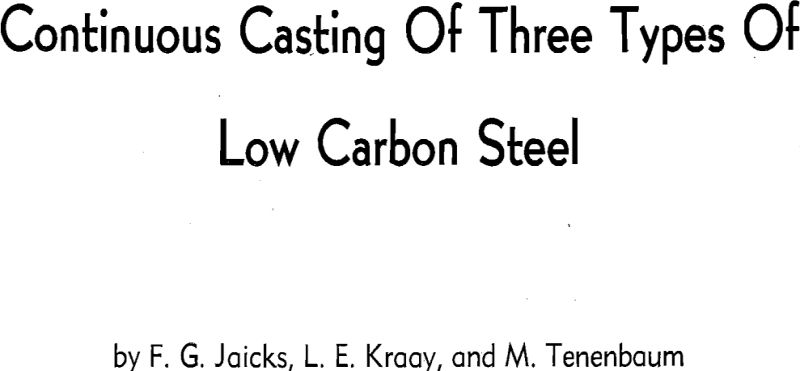Table of Contents
Recognition of the benefits to be gained from the continuous casting of molten steel into finished or semifinished products has been given by scientific minds since the very beginnings of steel plant technology. In fact, Sir Henry Bessemer is credited with the first of a long list of patents issued by the U. S. Patent Office for a process which would accomplish this desirable end. None of these early ideas attained practical success and, as a result, the conventional method of teeming into ingot molds became an integral part of modern steelmaking operations. This procedure, although refined to keep pace with the changes which have come about in steelmaking and finishing facilities, is recognized to have inherent shortcomings which adversely affect manufacturing costs and steel quality.
The original Junghans process was first developed in Germany. Further application of the process has been made by Rossi in other countries. The experi-

mental studies used as the basis for this report were carried out in a Rossi-type plant utilizing a Junghans reciprocating mold system and designed and built by the Koppers Co.
In conventional ingot casting practice there are four types of steel that are normally used for the making of low carbon sheet products. The greatest proportion of low carbon hot and cold rolled sheets is obtained from rimming steel. The dominant position of rimming steel for such low carbon applications stems from the three factors, each of which is directly or indirectly related to the fact that large volumes of gas are evolved during ingot solidification. First, rimming steel may be produced without making major deoxidizing additions to the liquid metal tapped from the furnace. Second, a reasonable surface quality can be obtained without resorting to costly surface conditioning of the rolled product. Third, a high ingot to product yield can be attained simply by exercising moderate controls during the teeming period. The advantages resulting from this combination of factors have led to the widespread adoption of this type of steel for the manufacture of steels for cold pressing applications.

Description of Facilities
The continuous casting studies were carried out on a casting machine located adjacent to a steel-

making shop which was comprised of six tilting electric furnaces in a line. The rated capacities of the individual electric furnaces in the shop ranged from 6 to 50 tons. The heats that were cast in this study were melted in either a 6 or a 30 ton electric furnace.
The casting facilities were located in a tower-type building extension in line with and just beyond one end of the electric furnace shop. The steelmaking plant included a conventional casting bay where most of the tonnage produced was poured into hot top molds from standard bottom-pour-ladles. (The term bottom-pour-ladle refers to the fact that liquid metal flowed from the ladle through a nozzle located in its bottom rather than through a specially designed orifice located at the lip.)

The casting plant facilities, which have been described elsewhere are shown schematically in Fig. 1. The casting machine facilities included the previously mentioned operating floor, a completely enclosed apron spray section 20 ft above pit floor level, withdrawal roll and mold oscillating equipment 10½ ft above pit floor level, provision for burning off billets and slabs at nit floor level, and equipment for removing the cut cast sections located in a pit below pit floor level.
A covered refractory-lined trough-type tundish suitable to receive metal from the tapping ladle was positioned so that one end was over the emergency ladle. This end was left uncovered to receive the metal. The trough nozzle which fed the molten metal to the casting mold was set in the opposite end. Magnesia and zirconia nozzles were used in the trough throughout the test. The nozzle bores were round and ranged from ¾ to 1 1/8 in. diam, depending on the flow rate desired.
The casting mold was provided with small outlets around its entire top surface through which regulated quantities of rapeseed oil were passed during casting. The oil ran down the mold walls to act as a lubricant for the solidifying casting shell as it moved vertically downward through the mold. The mold was supported by a table which was linked to the withdrawal rolls. Through this linkage, a vertical oscillation was imparted to the mold during the cast.
The apron spray equipment was located immediately below the operating floor. In the apron spray zone, the continuously cast bar, withdrawn from the mold, was sprayed with sufficient water to effect substantially complete solidification.

Below the level of the spray chamber were two sets of motor driven smooth rolls which supported the vertically cast bar and controlled its rate of withdrawal from the casting mold.
General Sequence of Casting Plant Operations
In these studies, a total of 31 heats were produced and delivered to the casting machine. Because of operating difficulties, casting plant data were obtained on only 27 of these heats.
As indicated in the description of the casting plant, continuous casting of steel is a succession of vital operations, the most prominent of which are: 1) delivery of liquid metal to the plant in refractory lined ladles; 2) flow of metal from the ladle, through a distributor trough, and into the casting mold; 3) formation of the cast section in the water- cooled mold; 4) withdrawal of the casting from the mold; 5) heat removal from the casting; 6) cutting the cast bars; and 7) removal of cut lengths of the cast bars.
There were few deviations from normal furnace and tapping practices in the test heats. Tap temperatures were controlled to a range consistent with those used in conventional casting practice for similar steel grades. Slag was removed from the furnace just prior to tap in order to reduce the volume of hot slag carried in the ladle.
The troughs were preheated to approximately 2800°F before casting was started. During the pouring operation, heat loss was combatted by introducing fuel and oxygen into the trough. This technique proved very effective. The average temperature of the metal entering the trough was close to 2900°F. With the use of fuel and oxygen in the trough the average temperature of the metal entering the mold was about 2840°F. With these temperatures, the metal flowed readily into the casting mold and uniform operating conditions could be attained. (The preceding temperatures were obtained by means of an optical pyrometer with an emissivity correction of 0.4.)
Prior to opening the ladle nozzle for the first time, mold cooling water was introduced. Suitable precautions were taken to prevent condensation on the inner mold walls. The ladle stopper was opened to an immediate full stream and the liquid metal was allowed to flow freely through the trough and into the casting mold. The trough stream characteristics did not attain the desired degree of sharpness until a reasonable head of metal was developed in the trough. However, no adverse effects resulted from the early ragged stream characteristics, presumably because the original flow collected against a retractable stool in a manner similar to conventional casting.
Operations at the casting level during a cast consisted of 1) controlling the metal level in the trough, through repeated interruption of the ladle stream by means of the stopper mechanism; 2) controlling the level of metal in the mold by means of control equipment regulating the speed of revolution of the withdrawal rolls; and 3) controlling the deoxidation of the metal through the use of an aluminum wire feeder which fed controlled amounts of deoxidizing aluminum into the trough stream. Indication of the need for greater or lesser amounts of deoxidizing additions was obtained through observation of the metal behavior in the mold and the examination of the torch cut sections of material already cast.
Casting of Rimming Steel
The rim steel heats were worked down to low carbon, using lance oxygen and ore for carbon removal. Because of difficulties in coordinating steel refining and casting plant activities, it was not uncommon to hold heats in the furnace at a low carbon for a prolonged period. Accordingly, the oxidation level of the metal at tap was somewhat higher than would be expected for electric furnace rimming steel poured into conventional ingots.
The standard ladle deoxidation for rimming steel to be continuously cast was 0.6 lb Al per net ton of liquid metal. In experiments directed toward evaluating the effect of ladle deoxidation on rim thickness and the control of metal action in the mold, the ladle aluminum was varied in the range from 0.5 to 0.8 lb per net ton. This level of ladle deoxidation is recognized to be considerably higher than that used in conventional casting of rimming steel. Three factors contributed to this higher aluminum requirement. First, the metal was held in the furnace for a prolonged period at low carbon, and this led to increased oxidation. Second, the slag was removed from the furnace prior to tap and for a brief period, therefore, the bare metal surface was ex¬posed to the oxidizing furnace atmosphere, a condition which also would lead to a higher oxygen level in the steel.
As described earlier, one of the techniques used to ensure adequate casting temperature involved directing a stream of gaseous oxygen onto the surface of the liquid metal as it flowed through the trough. It was estimated that the oxygen was introduced into the trough at a rate of about 60 cu ft per min. It would normally be expected that in an operation where a stream of oxygen is directed over the liquid metal, reactions would take place which would interfere both with the meeting of the desired ladle analysis and with the control of metal action in the mold.
Casting of Killed Steel
Both aluminum and silicon deoxidized steels were cast, using the 24 x 6½ in. section slab mold. Early in this work it became evident that there were two serious problems associated with the continuous casting of low carbon aluminum bearing steels. First, killed steels containing aluminum in the same range as is now being used for cold rolled sheet applications did not flow readily through zirconia or magnesia nozzles. Second, with any significant percentage of soluble aluminum in the liquid metal, there was an extreme tendency toward formation of a refractory crust over the surface of the metal in the mold.
Again it was found necessary to use the oxygen and gas heating techniques described earlier in order to hold the temperature of the metal passing through the trough nozzle well above the value normally considered critical. Unlike the rimming steel heats there was little change in manganese content as the steel passed through the trough.
The casting rate for the high silicon steel built up to a maximum after 10 min, remained fairly constant, and then dropped off rapidly toward the end of the cast. This late decrease in casting speed was associated with a restriction to flow caused by metal freezing in the refractory trough nozzle. During most of the cast, the mold water temperature remained reasonably constant. Despite the application of a constant water volume in the secondary sprays, a steady outlet temperature was not reached.
Casting of Semikilled Steel
In conventional casting, semikilled steels are generally used in order to obtain maximum yield of acceptable product from a given ingot weight. The shrinkage that occurs characteristically during solidification of semikilled steel is compensated, at least in part, by a controlled amount of gas formation. An important attribute of the continuous casting process is that, by its very nature, the shrinkage occurring during solidification is compensated for by the continuous flow of liquid metal into the mold. A question may then be raised regarding the purpose for continuously casting a semikilled type of steel. A similar question may also be raised regarding the casting of rimming steel.
The refining practice used on the low carbon semikilled steel heats was generally the same as that used on rimming steels. The heats were worked down to low carbon content, slag removed, and the refined metal tapped. Dooxidizers, ferromanganese, and slag thickening agents were added to the ladle. Final deoxidation was adjusted through controlled mold aluminum addition. This mold aluminum addition varied from 0.10 to 0.40 lb per net ton, depending on the casting conditions and the practice feature being studied.
In these studies the rate at which mold water was applied ranged from 200 to 250 gpm. It was interesting to note that, in this range, the effect of changes in rate of water flow on the rate of heat removal in the mold was too small to be recognized.
Because of the arrangement of the equipment, it was not possible to obtain an accurate measure of temperature of the frozen shell of the slab between the mold and the secondary water sprays. A few crude optical pyrometer measurements were taken which indicated that the outer slab surface temperature was in the order of 2100°F as the casting emerged from the mold. Using these temperature values and assuming a constant temperature gradient across a uniform solidified shell, it is possible to estimate the thickness of the frozen outer skin at the time that the casting emerged from the mold. For the 24 x 6½ in. mold the formula for shell thickness has the form
D = 7.63 √59.25 – 0.22 ΔH/M
where D is the thickness of emerging shell in inches; ΔH is the rate of heat removal in mold, Btu per min; and M is the casting rate, lb per min.
Plant Capacities
The bulk of the work done in this study was carried out in a 24 x 6½ in. mold. The 24 in. width was selected since it was the largest size that could be fitted into equipment available for the study. It would have been desirable to carry out the studies in molds up to 40 in. wide since the range from 24 to 40 in. slab width is probably the most popular for the slabs being used in the manufacture of cold rolled sheet and strip in the United States. In the absence of actual data on wider slabs, it was assumed that the casting speeds attained on the narrower slabs could be attained when producing sections of the same thickness up to 40 in. wide. On this basis, the information obtained in this study was extended to indicate the annual capacity of a single strand casting slabs up to 40 in. wide.
Consider a plant producing a 40 x 6½ in. semi-killed steel slab at an average speed of 35 in. per min. It can be calculated that each strand of such a plant can cast about 70 tons per operating hr. In normal bottom-pour-ladle practice, a 1 hr period is regarded as about the maximum casting time that can be considered reasonable. With the present status of continuous casting, some time must be allowed between heats to prepare to receive the next cast. On the basis of experience to date, it was assumed that with a properly engineered machine about 50 pct utility of the casting strand could conceivably be attained. Under these conditions, each strand could cast an average of about 840 tons of slabs daily.

